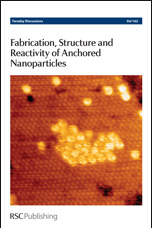It is well known that gold nanoparticles supported on TiO2 act as a catalyst for CO oxidation, even below room temperature. Despite extensive studies, the origin of this catalytic activity remains under debate. Indeed, when the particle size decreases, many changes may occur; thus modifying the nanoparticles' electronic properties and consequently their catalytic performances. Thanks to a state-of-the-art home-developed setup, model catalysts can be prepared in ultra-high vacuum and their morphology then studied in operando conditions by Grazing Incidence Small Angle X-ray Scattering, as well as their atomic structure by Grazing Incidence X-ray Diffraction as a function of their catalytic activity. We previously reported on the existence of a catalytic activity maximum observed for three-dimensional gold nanoparticles with a diameter of 2–3 nm and a height of 6–7 atomic planes. In the present work we correlate this size dependence of the catalytic activity to the nanoparticles' atomic structure. We show that even when their size decreases below the optimum diameter, the gold nanoparticles keep the face-centered cubic structure characteristic of bulk gold. Nevertheless, for these smallest nanoparticles, the lattice parameter presents anisotropic strains with a larger contraction in the direction perpendicular to the surface. Moreover a careful analysis of the atomic-scale morphology around the catalytic activity maximum tends to evidence the role of sites with a specific geometry at the interface between the nanoparticles and the substrate. This argues for models where atoms at the interface periphery act as catalytically active sites for carbon monoxide oxidation.
You have access to this article
 Please wait while we load your content...
Something went wrong. Try again?
Please wait while we load your content...
Something went wrong. Try again?

 Please wait while we load your content...
Please wait while we load your content...